Comic Planner – Free Templates for Preparing Your Comic
Comic Planner Overview
This comic planner will help you prepare and organize your comic. This article explains the different templates and resources included in the comic planner, and how to use them. To use the planner, simply download the pages, and fill them out digitally or on paper. The pages are 8.5 x 11 inches, so they fit well printed out and placed in a binder.
This planner is helpful for people who are planning a new comic or already creating one. Also, this planner is designed for people who are creating a long comic. For example, this planner is intended for people making a graphic novel, serialized comic issues, a comic anthology, an episodic Webtoon, or a long format webcomic.
The planner was developed using my knowledge from completing two webcomics. While making those comics, I accumulated a lot of notes and plans. I turned those notes and plans into templates that anyone can use to make a comic. The planner is proving very useful as I develop my third comic. It helps me to keep track of what I need to do, and it helps me keep organized. I hope it can prove just as helpful for you.
What Is Included in the Comic Planner?
This planner is a digital PDF file that you can download for free. There are several planning pages, as well as charts for you to fill out. The specific pages and templates in the planner are listed and shown below:
- Getting Started
- Preparation Checklist
- Basic Info. Planner
- Character Chart
- Story Planner
- Progress Tracker
- Update Scheduler
- Thumbnails (Small & Large)
- Password Organizer
- Physical Book Plan
- Advertising Plan
- Revenue Plan
- Example Drawing Prep
- Resources
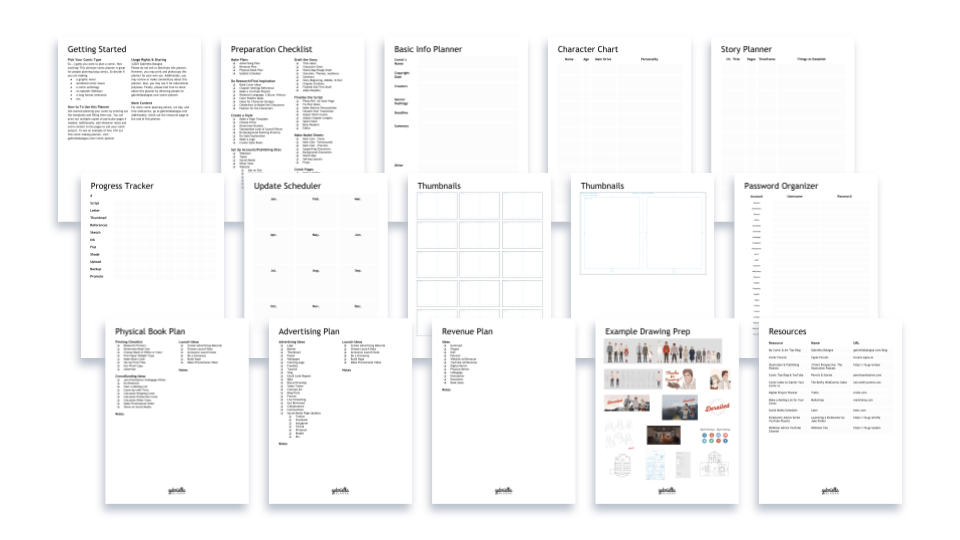
Comic Planner Usage Rights & Sharing
This comic planner is copyrighted 2021 by Gabriella Balagna. Please do not sell or redistribute this planner. However, you may print and photocopy it for educational or personal uses. Additionally, you may review or make commentary about this planner. Furthermore, please feel free to share about this planner by directing people to this page. The url is: gabriellabalagna.com/comic-planner
Why Is the Comic Planner Free?
I want to help others not just make comics, but make amazing comics! Also, I want to help people plan out their comics, so they will have an easier time completing them. It can be overwhelming trying to keep track of so many different things when making a comic, so this planner will help people stay organized. Additionally, by sharing the planner I can get feedback on what I should add to it. This will help me make my comic, Kindred Not, even better.
The Comic Planner Pages/Templates
Following are descriptions of each of the pages/templates in the planner.
Preparation Checklist
A very helpful page in the planner is the Preparation Checklist, which is shown below. This gives an overview of some things you may want to do before starting your comic. Additionally, it helps you keep track of your progress when making your comic. It is not mandatory to complete everything on this checklist, but it is helpful to complete at least some of these items before publishing your comic. Furthermore, you can always customize the list however you like to suit your comic’s needs.
Personally, this is my favorite template in the comic planner. It helped me to keep track of all the prep work I needed to do for making my next comic. You can read more about the prep work for my comic and get some helpful insight on developing a comic.
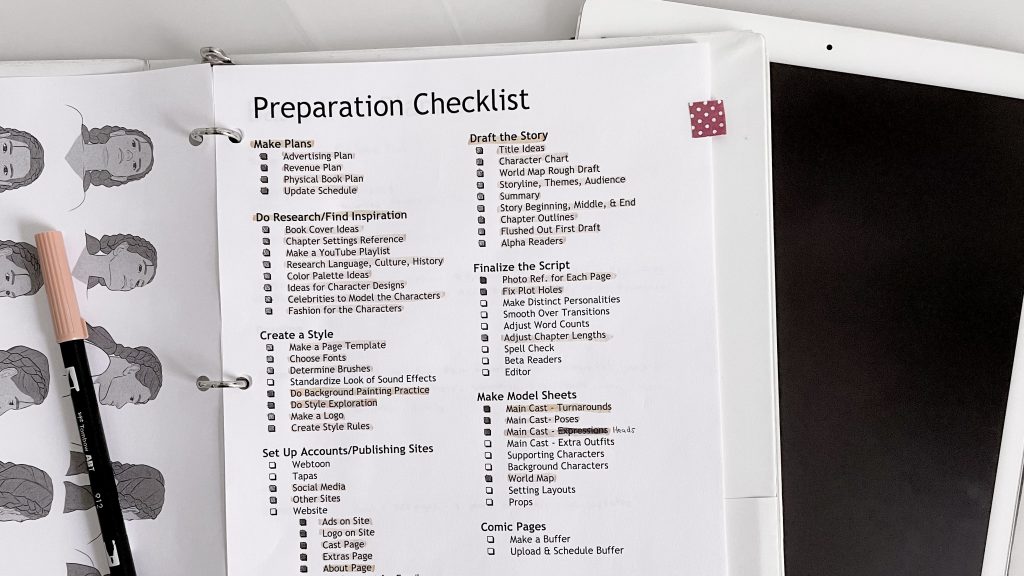
Basic Info Planner
Use the Basic Info Planner page to help establish some important things for your comic. For example, when preparing a new comic you should determine a good name for it, keep track of when you started making it, and what genre it will be. You may also want to set an estimated deadline for when you want to have your comic completed. This template will help you keep track of all these things.
Character Chart
The Character Chart page included in the comic planner will help you better understand your characters. Additionally, it will help you keep track of their ages and personalities. Also, filling out this chart is helpful in ensuring that each of your comic’s characters will have unique and deep backstories. Giving each character a main drive will help you understand how each character should act and how they will evolve as your comic progresses. Moreover, writing down a goal for each character will help you plan what needs to happen in your comic.
This chart is super helpful for understanding each of my characters’ personalities. Likewise, it helped me to figure out how they should look. As well, it helped me to write the bios for them on my comic’s cast page.
Story Planner Chart
The Story Planner page included in the comic planner will help you establish an outline for your comic. This chart will help you determine how many chapters and/or pages you want your comic to have. It also has a column called “time” to help you keep track of how much time passes in each chapter. Filling out this template ensures that each chapter of your comic will progress your story, rather than just be “talking heads” or filler.
Once you have your story planned out, get some tips on how to write a comic script.
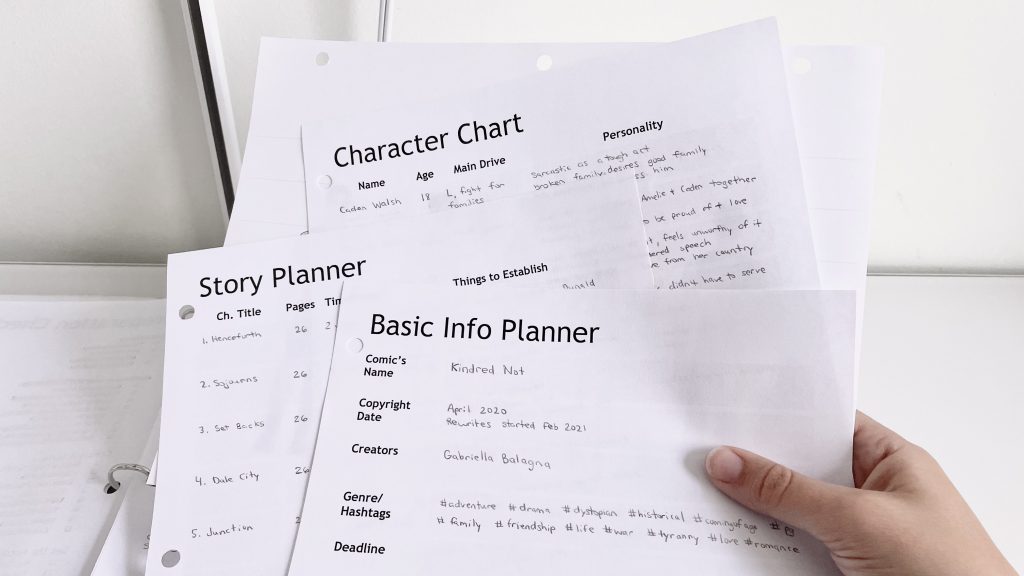
Progress Tracker & Update Scheduler
The Progress Tracker template included in the comic planner helps you to keep track of your productivity. You can use it to track your progress page-by-page or for each chapter/episode of your comic. As you complete each step, shade in the boxes on chart. Watch with satisfaction as the chart fills up and your comic gets completed. The image below shows an example of the Progress Tracker.
Having trouble completing your goals? Read these productivity tips for artists.
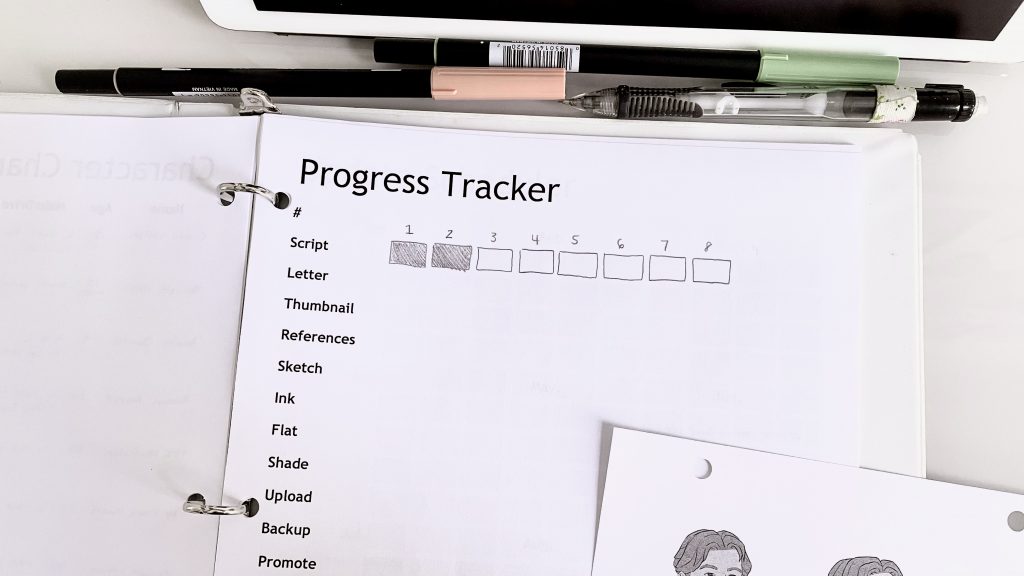
Thumbnails
The Thumbnails pages included in the comic planner are great for some quick planning of your comic pages. You can make little doodles to plan out your pages and make sure your story flows well. Then, use the larger thumbnail page to make a more detailed plan for an individual comic spread. There is even space in the margins to add in notes and list out the dialogue.
Advertising, Revenue, & Physical Book Plans
The comic planner includes planning pages for Advertising, Revenue, and Physical Book Printing. Just drawing a comic can be overwhelming, so these planning pages help give some ideas on the monetization side of making a comic. They also leave room for you to take notes on how you plan to approach each of these things for your comic.
Password Organizer
The Password Organizer form might seem like a strange addition to a comic planner. However, as you make your comic you will quickly realize just how many accounts you make online. For example, you will likely use multiple social media accounts to promote your comic. You may also post your comic to several different sites, such as Webtoons, Tapas, WordPress, and comic indexes. This template will help you to keep track of all your usernames and passwords for these sites. Speaking from experience, there is nothing worse than forgetting a password when trying to upload your comic online.
Example Drawing Prep
The Example Drawing Prep page included in the comic planner is very helpful. It gives some example drawings that you may want to prepare for your comic. For example, background characters, a series’ thumbnail, a banner, a book cover, and a logo. As you prepare each of these things for your comic, go ahead and check them off, as shown below.
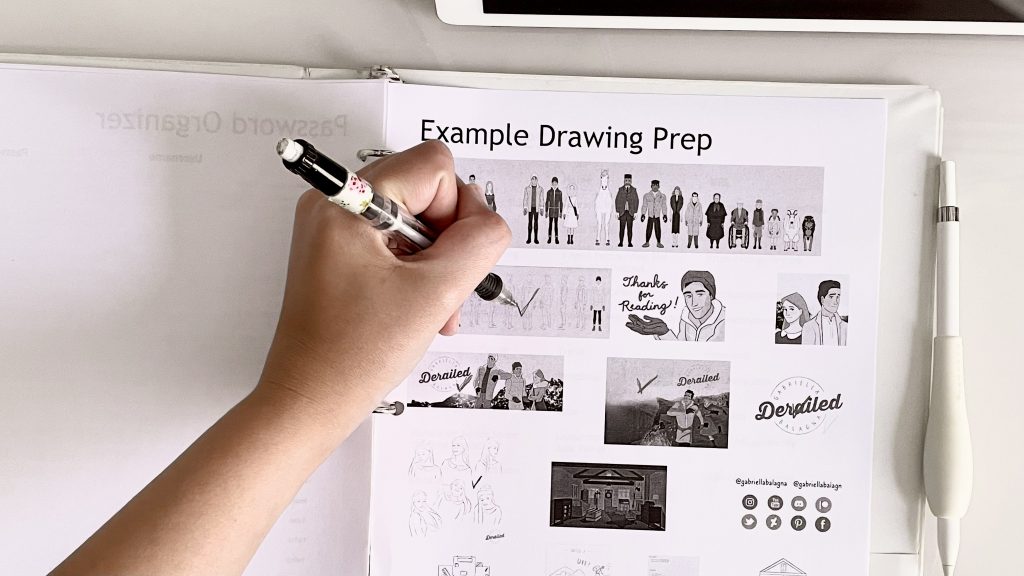
Resources
Lastly, the Resources page included in the planner provides a variety of links that give information about making comics. For instance, it lists helpful YouTube channels and blogs about how to make comics. You can also use this page to write down any helpful comic making resources you find so that you will not lose track of them.
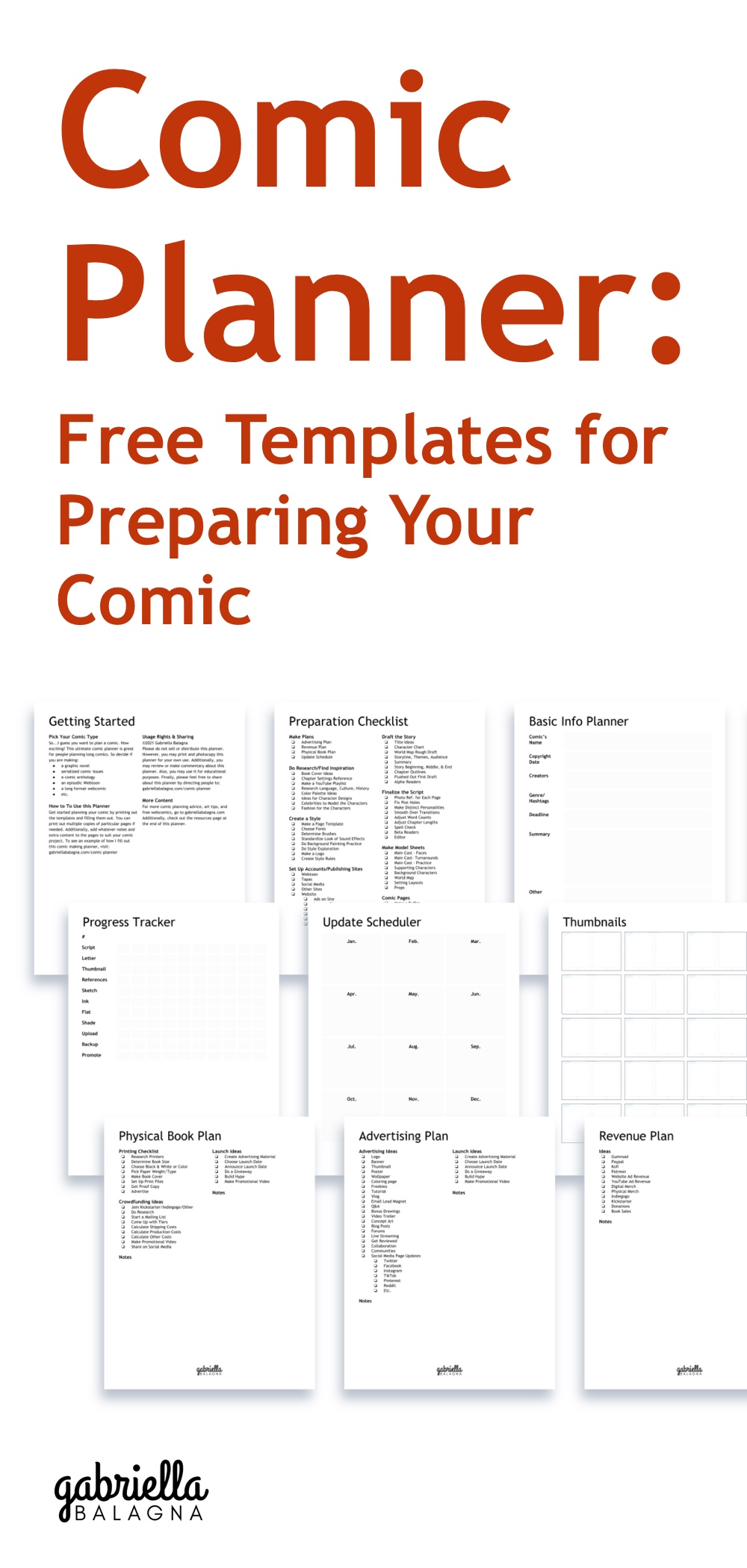
Start Planning Your Comic!
Download the free comic planner PDF below to start creating and organizing your comic. I hope the templates help your comic turn out amazing. If you have any questions or feedback, be sure to leave a comment below.
Additionally, read more about how to make a webcomic.
Also, for more free content like this subscribe, or check out my other comic-making resources.

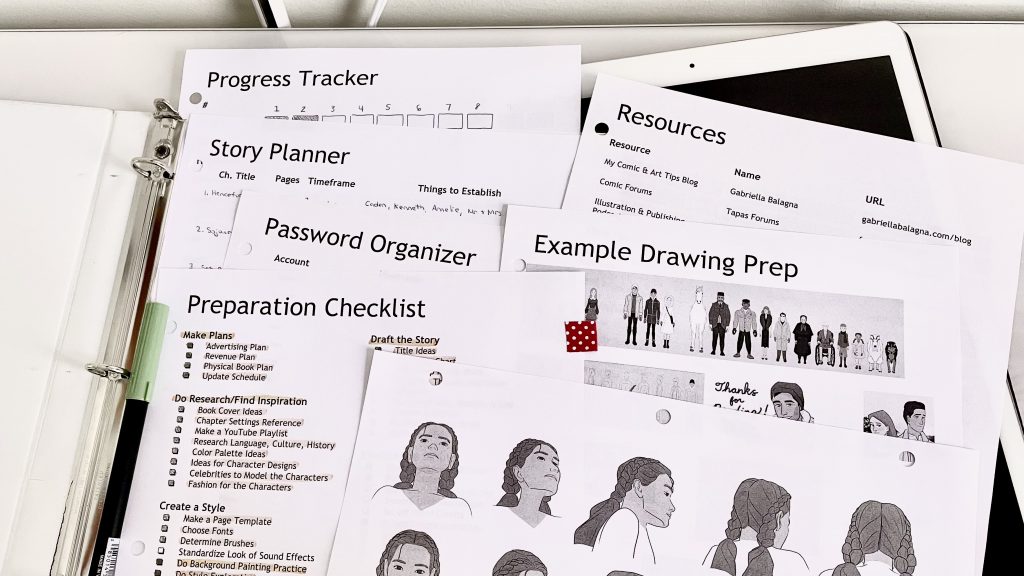
Discussion (2) ¬